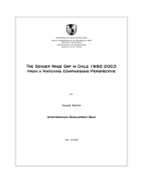The Gender Wage Gap in Chile 1992-2003: From a Matching Comparisons Perspective
Date
May 2006
This paper analyzes the evolution of the gender wage gap in Chile during the period 1992 to 2003 using the decomposition approach developed in Ñopo (2004). This approach, which decomposes the wage gap into four additive elements, stresses the need for comparisons inside the common support for the distributions of observable characteristics of individuals. Also, it allows an analysis of the distribution of unexplained differences in wages (not only the averages). The results suggest that, besides the high educational attainment of females, there are noticeable gender wage gaps in Chile favoring males. These unexplained differences in wages, which move around 25 percent of average female wages, show no clear tendency during the period of analysis. The wage gaps are higher at the highest percentiles of the wage distribution, among those with higher educational attainment, among directors and among part-time workers. The technique also detects some evidence of a glass-ceiling effect in Chilean labor markets, such that for some occupations and particular combinations of observable characteristics, there are highly paid males but not females.



